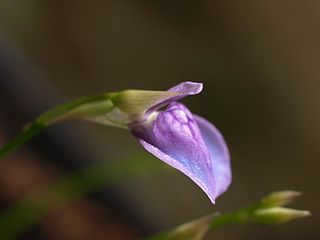Utricularia albiflora is a terrestrial carnivorous plant that belongs to the genus Utricularia. It is endemic to Queensland, Australia.
Utricularia arnhemica is an affixed aquatic or terrestrial carnivorous plant that belongs to the genus Utricularia. It is endemic to the Arnhem Land area in the Northern Territory of Australia.
Utricularia dunstaniae is an annual terrestrial carnivorous plant that belongs to the genus Utricularia. Its distribution ranges from northern Western Australia to the Northern Territory.
Utricularia hamiltonii is an affixed aquatic carnivorous plant that belongs to the genus Utricularia. It is endemic to the Northern Territory of Australia.

Utricularia petertaylorii is an annual terrestrial carnivorous plant that belongs to the genus Utricularia. It is endemic to southwestern Western Australia. It is named in honor of Peter Taylor.
Utricularia kimberleyensis, the Kimberley bladderwort, is a terrestrial carnivorous plant that belongs to the genus Utricularia. Its distribution ranges from the Dampier Peninsula in northern Western Australia to the area around Darwin in the Northern Territory.
Utricularia lasiocaulis is an annual terrestrial carnivorous plant that belongs to the genus Utricularia. Its distribution ranges from Western Australia through the Northern Territory and into Queensland, Australia.
Utricularia leptorhyncha is an annual, terrestrial carnivorous plant that belongs to the genus Utricularia. Its distribution ranges from Western Australia to the Northern Territory.
Utricularia quinquedentata is an annual, terrestrial carnivorous plant that belongs to the genus Utricularia. Its distribution ranges across northern Australia from Western Australia to northern Queensland and south to Brisbane. It was first identified by Ferdinand von Mueller as possibly a new species or variety in the early 1890s, noting it as "U. albiflora or a closely allied species." Mueller labeled one herbarium sheet as Utricularia albiflora var. quinquedentata. Without a valid description, according to the rules of botanical nomenclature, however, the epithet quinquedentata was not recognized until Peter Taylor validly published the species in 1986.
Utricularia pachyceras is a terrestrial carnivorous plant that belongs to the genus Utricularia. It is endemic to Western Australia and the Northern Territory.
Utricularia tubulata is a suspended aquatic carnivorous plant that belongs to the genus Utricularia. Its distribution ranges across northern Australia from Western Australia through the Northern Territory and into Queensland.

Utricularia uniflora is a terrestrial carnivorous plant that belongs to the genus Utricularia. Its distribution ranges across southeastern Australia from extreme southeastern Victoria through New South Wales to southern Queensland. It is also found in Tasmania.

Utricularia biloba, the moth bladderwort, is a perennial, terrestrial or aquatic carnivorous plant that belongs to the genus Utricularia. It is endemic to Australia with a distribution along the coastal regions of New South Wales and Queensland.
Utricularia leptoplectra is a terrestrial or subaquatic carnivorous plant that belongs to the genus Utricularia. It is endemic to Australia with a distribution in the Northern Territory from the area around Darwin, east to the Arnhem Land plateau, south to Katherine, and west to the western Kimberley region in Western Australia.
Utricularia limosa is a terrestrial or subaquatic carnivorous plant that belongs to the genus Utricularia. It is native to Southeast Asia, Australia, China and New Guinea.
Utricularia simmonsii is a small annual or perennial terrestrial carnivorous plant that belongs to the genus Utricularia and is the only member of Utricularia sect. Minutae. U. simmonsii is endemic to Australia and is only known from a few locations in the Northern Territory and Queensland. It and the section Minutae were originally published and described by Allen Lowrie, Ian D. Cowie, and John Godfrey Conran in 2008. It was named in honor of Paul Simmons, who discovered the species in Queensland in 2005.

Utricularia babui is a perennial carnivorous plant that belongs to the genus Utricularia. It is native to India and had only been collected from the Kolhapur district at the time of its description in 2005. U. babui grows as a terrestrial plant in and near small streams in open forests at altitudes from 700 m (2,297 ft) to 900 m (2,953 ft). Specimens of U. babui were previously mistaken for U. graminifolia. It was originally described and published by Shrirang Ramchandra Yadav, M. M. Sardesai, and S. P. Gaikwad in 2005.
Utricularia linearis is a carnivorous plant belonging to the genus Utricularia. It is known only from a single unnamed lagoon in Howard Springs, Northern Territory, Australia.
Utricularia ameliae is a terrestrial carnivorous plant belonging to the genus Utricularia. It is only known from the discharge mound spring habitats of far western Queensland, Australia.



